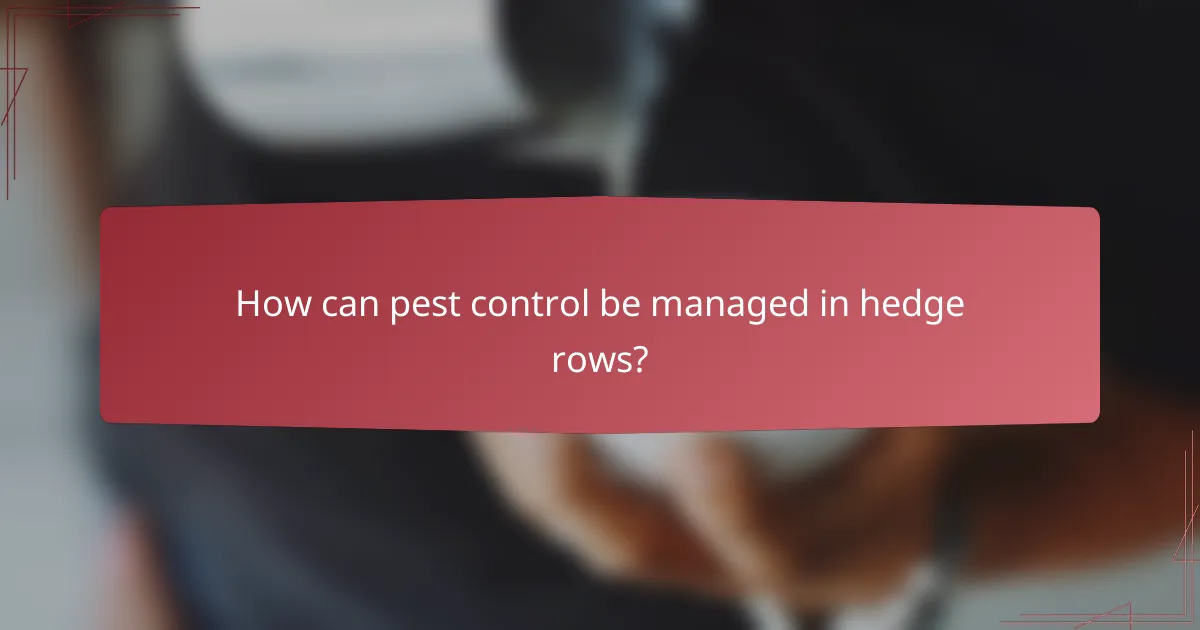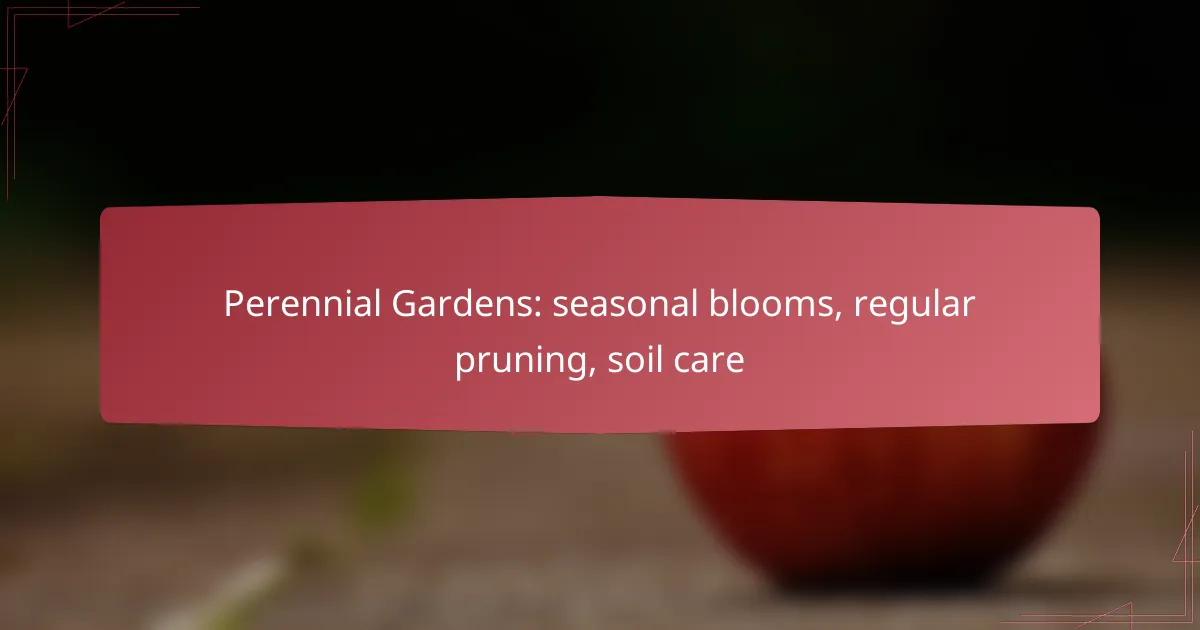Hedge rows are an essential element of landscaping, requiring careful shaping techniques such as topiary shaping, layering, and pollarding to achieve desired aesthetics and plant health. Effective pest control strategies, including the use of natural predators and organic pesticides, help maintain a thriving ecosystem while ensuring the longevity of the hedges. Regular growth monitoring and the right tools are crucial for maintaining their structure and vitality.

What shaping techniques are effective for hedge rows?
Effective shaping techniques for hedge rows include topiary shaping, layering, and pollarding. Each method serves unique purposes and requires specific care to maintain the desired shape and health of the plants.
Topiary shaping
Topiary shaping involves trimming hedges into ornamental shapes, enhancing aesthetics in gardens and landscapes. This technique requires regular maintenance to keep the desired forms, often using hand shears or electric trimmers for precision.
When engaging in topiary, select plants that respond well to shaping, such as boxwood or yew. Regular trimming should be done during the growing season, typically in late spring or early summer, to promote healthy growth and maintain the shape.
Layering technique
The layering technique encourages new growth by bending and burying branches of the hedge into the soil, allowing them to root while still attached to the parent plant. This method is particularly useful for propagating plants and thickening hedges.
To perform layering, choose flexible branches and secure them in a trench filled with soil, ensuring the tip remains above ground. This can take several months, so patience is essential. It’s best to execute this technique in early spring when plants are actively growing.
Pollarding method
Pollarding is a pruning technique where the upper branches of a hedge are cut back to promote new growth from the trunk or main stems. This method is effective for controlling height and encouraging bushy growth, making it suitable for urban areas where space is limited.
When pollarding, it’s crucial to do so during the dormant season, typically in late winter, to minimize stress on the plant. Regular pollarding every few years helps maintain the desired size and shape while promoting healthy foliage development.

How can pest control be managed in hedge rows?
Pest control in hedge rows can be effectively managed through a combination of natural predators, organic pesticides, and regular inspections. These methods help maintain a healthy ecosystem while minimizing chemical use and promoting biodiversity.
Natural predators
Utilizing natural predators is a sustainable way to control pests in hedge rows. Beneficial insects such as ladybugs, lacewings, and predatory wasps can significantly reduce pest populations by feeding on them. Introducing or encouraging these predators can create a balanced environment where pests are kept in check without harmful chemicals.
To attract natural predators, consider planting a variety of flowering plants that provide nectar and pollen. This diversity not only supports beneficial insects but also enhances the overall health of the hedge row.
Organic pesticides
Organic pesticides offer an alternative to synthetic chemicals for managing pests in hedge rows. Products derived from natural sources, such as neem oil or insecticidal soap, can effectively target specific pests while being less harmful to beneficial organisms. When selecting organic pesticides, ensure they are approved for use in your region and follow application guidelines closely.
It’s advisable to apply organic pesticides during cooler parts of the day to minimize harm to non-target species and to avoid applying them during flowering periods to protect pollinators. Regularly rotating different types of organic pesticides can also help prevent pests from developing resistance.
Regular inspections
Conducting regular inspections of hedge rows is crucial for early detection of pest issues. By monitoring for signs of pest activity, such as unusual leaf damage or droppings, you can take timely action to mitigate infestations. Aim to inspect your hedge rows at least once a week during the growing season.
During inspections, look for both pests and their natural predators to assess the overall health of the ecosystem. Keeping detailed records of pest sightings and treatments can help you identify patterns and improve your pest management strategies over time.

What tools are recommended for hedge row maintenance?
For effective hedge row maintenance, essential tools include hedge trimmers, pruning shears, and garden rakes. Each tool serves a specific purpose, contributing to the overall health and aesthetics of your hedges.
Hedge trimmers
Hedge trimmers are designed for shaping and trimming hedges quickly and efficiently. They come in manual and electric varieties, with electric models often providing a faster and less labor-intensive option.
When selecting hedge trimmers, consider the size of your hedge and the thickness of the branches. For thicker branches, opt for a model with a larger cutting capacity, typically around 20-25 mm. Always prioritize safety by using protective gear and ensuring the trimmer is well-maintained.
Pruning shears
Pruning shears are ideal for more precise cuts and are essential for maintaining the health of your hedge rows. They allow for targeted trimming of individual branches, promoting better air circulation and light penetration.
Choose between bypass and anvil shears based on your needs; bypass shears are better for live branches, while anvil shears are suited for dead wood. Regularly sharpen the blades to ensure clean cuts, which helps prevent disease in your plants.
Garden rakes
Garden rakes are useful for clearing debris from around your hedge rows, which can help prevent pests and diseases. Keeping the area tidy allows for better growth and easier maintenance.
When using a garden rake, opt for a lightweight model that can easily maneuver around your hedges. Regular raking after trimming sessions will keep your garden looking neat and can help you spot any potential pest issues early on.

What are the best practices for growth monitoring in hedge rows?
Effective growth monitoring in hedge rows involves regular assessments of plant height, soil health, and growth rates. These practices help ensure that hedges remain healthy, well-shaped, and effective for their intended purposes, such as privacy or wildlife habitat.
Regular height checks
Conducting regular height checks is essential for maintaining the desired shape and size of hedge rows. Aim to measure the height at least once a month during the growing season, using a measuring tape or a marked stick for accuracy.
Consider marking the ideal height on a reference post nearby to easily compare growth over time. If growth exceeds the desired height, plan for timely trimming to maintain the hedge’s shape and functionality.
Soil health assessments
Assessing soil health is crucial for promoting robust growth in hedge rows. Regularly test the soil for pH levels, nutrient content, and moisture retention, ideally every 1-2 years. Soil testing kits are widely available and can provide valuable insights.
Incorporate organic matter, such as compost, to improve soil structure and fertility. Healthy soil supports strong root systems, which in turn enhances the overall vigor and resilience of the hedge.
Growth rate tracking
Tracking the growth rate of hedge rows helps identify any issues early on. Measure the growth from the base to the top of the hedge at regular intervals, such as monthly or quarterly, depending on the species and climate conditions.
Document the measurements to observe trends over time. If growth rates decline significantly, investigate potential causes such as pest infestations, nutrient deficiencies, or environmental stressors, and take corrective actions promptly.

What are the benefits of maintaining hedge rows in urban areas?
Maintaining hedge rows in urban areas offers numerous benefits, including improved air quality, enhanced biodiversity, and noise reduction. These natural barriers play a crucial role in creating healthier, more sustainable urban environments.
Improved air quality
Hedge rows act as natural filters, trapping dust, pollutants, and particulate matter from the air. By absorbing carbon dioxide and releasing oxygen, they contribute to cleaner air in densely populated areas.
To maximize air quality benefits, select native plant species that are well-adapted to the local climate. These plants generally require less maintenance and provide better filtration compared to non-native varieties.
Enhanced biodiversity
Hedge rows provide essential habitats for various wildlife species, including birds, insects, and small mammals. By creating corridors for these species, hedge rows promote biodiversity in urban settings.
Incorporating a mix of plant species in hedge rows can attract a wider range of wildlife. Consider planting flowering shrubs and trees that bloom at different times to support pollinators throughout the growing season.
Noise reduction
Hedge rows can significantly reduce noise pollution by acting as sound barriers. The density of foliage helps absorb and deflect sound waves, making urban areas quieter and more pleasant to live in.
For effective noise reduction, choose dense, tall plants that can grow to a sufficient height. Regular maintenance, such as trimming and shaping, will ensure that the hedge remains effective as a sound barrier over time.



